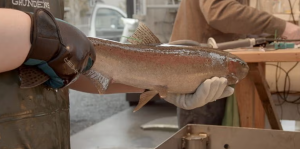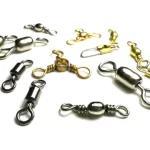A record-breaking number of adult steelhead have returned to the Pelton Round Butte hydropower project on the Deschutes River during the 2024-2025 migration season, marking a major victory for fish reintroduction efforts. More than 950 steelhead successfully passed upstream of Round Butte Dam—the highest count recorded since the 1960s. Experts credit this resurgence to improved ocean conditions and advancements in fish management practices.
The Confederated Tribes of Warm Springs and Portland General Electric (PGE), co-owners of the three-dam Pelton Round Butte complex, initiated a reintroduction program in 2010 to restore migratory salmon and steelhead populations to the Upper Deschutes Basin after more than five decades of restricted passage. Scientific models estimated an annual target of 955 returning steelhead based on available habitat, bringing this year’s run remarkably close to the goal.
“While this return is an incredible milestone, the work toward full restoration continues,” said Austin Smith Jr., natural resources manager for the Confederated Tribes of Warm Springs. “We remain committed to ongoing conservation efforts, adaptive management, and community education to ensure the long-term success of these runs.”

Of the 950 returning steelhead, 675 originated from Pelton Round Butte’s fish collection facility, where they were guided through juvenile passage systems as smolts. The Selective Water Withdrawal (SWW) facility at Lake Billy Chinook plays a crucial role in transporting young fish downstream past the dams and regulating water temperatures for better survival rates.
“The return of these steelhead is a testament to the strength of nature and our collaborative restoration efforts,” said Megan Hill, senior environmental science manager at PGE. “These fish undertook an extraordinary journey—passing through the SWW, traveling 100 miles down the Deschutes, then another 200 miles to the Pacific. After spending two years at sea, they made the grueling 300-mile trip back home. This year’s run proves how essential fish passage improvements and strong ocean conditions are to the survival of migratory species.”
The 2024 return also included 275 hatchery-origin steelhead, which were released upstream as supplemental broodstock to bolster the wild population. These fish, monitored for health and genetics, share identical traits with wild steelhead and play a key role in species recovery efforts.
Conservation groups and fisheries experts applauded the success.
“The Deschutes River Conservancy and its partners have spent over 15 years restoring streamflow and improving habitat in the Crooked River, Whychus Creek, and Metolius system,” said Kate Fitzpatrick, executive director of the Deschutes River Conservancy. “This is the largest steelhead return since reintroduction efforts began, proving that restoring anadromous runs to their native waters is possible.”
Terry Shrader, Pelton Round Butte mitigation coordinator for the Oregon Department of Fish & Wildlife, emphasized the importance of adaptive management. “The program’s adjustments over the years have clearly contributed to this strong return. Ocean conditions and improved freshwater migration pathways also played critical roles in this year’s success.”
NOAA Fisheries biologist Scott Carlon credited the collaboration of multiple agencies. “Seeing such a strong return from the reintroduction program is exciting,” he said. “PGE and the Confederated Tribes of Warm Springs have made operational improvements that significantly increased the number of juvenile steelhead and salmon reaching the ocean. This is a hopeful sign for future runs.”
Moving forward, biologists will continue tracking steelhead movements and spawning activity using radio telemetry. Some adults, known as kelts, may attempt a second migration to the ocean, while others will spawn in the Upper Deschutes Basin. Their offspring will eventually embark on their own journey downstream, continuing the cycle of restoration and renewal.
This season’s record-breaking steelhead return highlights the power of conservation, adaptive management, and the resilience of native fish populations. While challenges remain, the progress made in the Upper Deschutes Basin offers hope for the long-term recovery of these iconic fish.
Image/Source: waterpowermagazine





